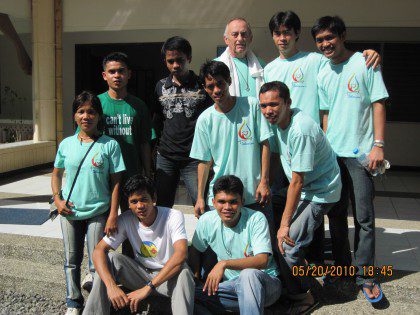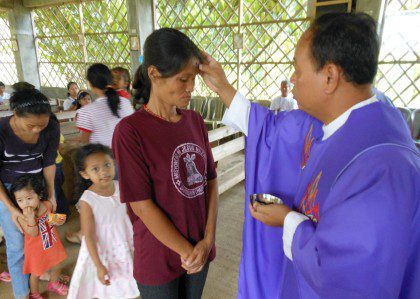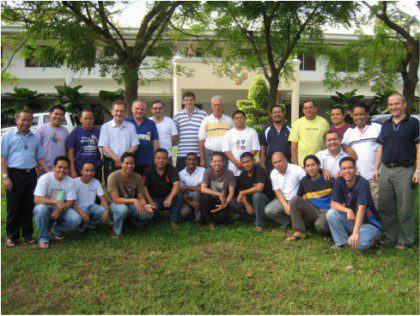
Philippine District gains “region status”
First regional administration to be installed on March 14
In 1989 a group of eight SCJs began preparations for the first SCJ mission in the Philippines. Ranging in age from 28 to 52, they included men from Argentina, Italy, Germany, the Netherlands, Poland, Indonesia and Great Britain.
For most, the first step in the process was becoming fluent in English. One of the two official languages of the Philippines, English would be the common tongue of the missionaries. In 1988 seven of the eight came to the U.S. Province to study in Sacred Heart School of Theology’s ESL program. The eighth, who already spoke English, joined them later.
The SCJs came to the U.S. Province learn a common language, but more importantly, they came together to develop a sense of community and shared goals for the new mission.
After months of preparation, the group arrived in the Philippines on May 17, 1989.
“Since the beginning we chose as our home one of the poorest and least developed islands, the island of Mindanao,” said a member of that first group. “Following the example set by our founder, Fr. Leo Dehon, the SCJs from the start have been involved in different social projects favoring the poor, the sick and the oppressed.”
In 1994 the SCJs established a formation program. The first Philippine novitiate class professed vows in 1999 and soon after, the Philippine mission became the Philippine District.
Now in 2012, that district becomes a region. A ceremony marking the occasion will be held on March 14, the commemoration of the founder’s birth.
Among those to be installed in the new regional council? Fr. John Karl Cabaluna, SCJ, a member of that first Filipino profession class.

Rapid growth
Eight SCJs came to Mindanao less than 25 years ago. Now as the district becomes a region, that initial eight has grown to include 55 professed SCJs. Seven of its 23 priests are Filipinos.
What was just a fledgling formation program in 1994 has evolved into a hub for SCJ studies in Asia. Joining Filipinos in the novitiate are novices from Vietnam and India. Last year, two Vietnamese SCJs who did their formation in the Philippines were ordained.
“Manila has become kind of a ‘Rome’ in Asia for theological studies,” said Fr. Francis Pupkowski, SCJ. A member of that first group of eight missionaries, Fr. Francis will serve as the new region’s first major superior.
Home to several internationally well-respected universities, Manila is a theological education center in Asia, not just for SCJs, but for the Church as a whole.
“We encourage SCJs from all over the world to do advanced studies, or take a sabbatical in Manila,” said Fr. Jose Benedito de Moraes Machado, SCJ, the out-going district superior. It is an opportunity for study, but also to learn about another reality of the congregation.”
Focus on Mindanao
As noted, the SCJs began their ministry in the Philippines on the island of Mindanao, one of the most challenging areas of the country.
“Those who are going to the Philippines should know that the place is not easy, it is not comfortable or poetic,” said Fr. Antonio Panteghini, SCJ, prior to the missionaries’ arrival in 1989. Fr. Antonio was superior general when the Philippine mission was initiated.
Mindanao is an island with a culture and history quite different from the rest of the country. It is the only area of the Philippines with a significant Muslim presence. Although not necessarily related to this presence, Mindanao is also an area plagued by violence and unrest.
The instability of the region hit close to home in October, 2001. After almost 10 years of missionary work in Mindanao, Fr. Giuseppe (Beppé) Pierantoni, SCJ, was kidnapped and held in captivity for 172 days.
“We have had to leave some places in Mindanao because of security reasons, but on the other hand, we want to expand to other places in the Philippines,” said Fr. Francis.
The location of SCJ ministry on Mindanao has changed but the original goals brought with that first group in 1989 are the same: to focus on “the poor, the sick and the oppressed.”
Pastoral ministry is always a part of that focus, but equally so is finding ways to help the people of Mindanao meet their basic needs. In Dimataling it means helping fishermen purchase nets so that they can feed and support their families. In Kumalarang it involves setting up a fund to help the poor buy medicine. In many areas, the focus is on education.
“In the Philippines the most important dream of every parent is that his or her child gets a good education,” said Fr. Bene. “Education is valued higher in the Philippines than anywhere else I have ever been; it is valued on all societal levels.
“Even in the poorest of areas, places where the people practically live in boxes next to trash dumps, the students will come to school well scrubbed in clean clothes with no dirt under their nails.”
In the more remote areas of Mindanao it is very difficult for young people to get to a school. To address this, the SCJs sponsor a boarding house for students from the Higaonon and Subanen tribes. Currently, they assist 40 students with shelter, food and other needs so that they can attend school on a regular basis. The house is a simple one, where the students not only help to prepare the meals, but often grow the vegetables that are a staple of their diet.
In 1999, Fr. Eduardo Agüero, SCJ, began the Kasanag Daughters Foundation. Kasanag is home to 26 girls and young women, age 11-24, who have been victims of sexual abuse. The foundation not only provides its residents with a safe haven, but psychological assistance and educational opportunities, including college.
Besides these residential programs, the SCJs also have a youth initiative. Begun in 1992, its focus is on giving children and teens an education in their Christian faith. It has also been a way of introducing young people from more “comfortable” economic backgrounds to the realities of those who are less advantaged.
And Christian formation isn’t just for the young. The Philippines is home to an extensive Lay Dehonian movement. Based in Cagayan de Oro, the Lay Dehonians are often young professionals “living out the spirituality of Fr. Dehon,” said Fr. Francis. Besides meeting for prayer and reflection, Lay Dehonians are very active in community outreach, including programs that focus on health, hygiene, nutrition, responsible parenthood, adult formation and moral issues.
Parish ministry widespread
Currently the SCJs are in four parishes in the Philippines. However, in many areas, a parish isn’t simply a single church and its community. Parishes on Mindanao generally have many small, remote chapels or mission communities attached to them. St. Isidore the Farmer parish in Dumalinao has 90 mission chapels ministered to by SCJs as well as over 100 lay ministers and150 catechists. The parishes also rely on Basic Ecclesial Communities (BEC), small, chapel-based faith groups. St. Isidore has 370 BEC leaders attached to it.

Dedicated to the poor, but also to Dehonian religious life
The SCJs went to the Philippines to serve the poor. But more so, they went to serve the poor as a religious community, as Dehonians committed not only to ministry but to each other in religious life.
“As an international community we give priority to community life,” said Fr. Francis. “We have monthly meetings, yearly assemblies, vacations together. All projects are community projects.
“In everything we do, we try to give a Dehonian flavor. We center our lives in prayer and adoration. Very often the people tell us that they see our charism lived in how we do things and how we interact.”
Members of the new regional administration are enthusiastic about the future of the SCJ presence in the Philippines. They note their expanding ministries, as well as growing vocation and formation programs. There is an increased focus on collaboration among all of the Asian SCJ entities. “Not only are we hosting students and novices from other entities but we have sent two of our Filipino theologians to Indonesia to learn about another SCJ reality,” said Fr. Francis.
There has also been collaboration with SCJ entities outside of Asia, especially with the German and U.S. Provinces. “With the help of the U.S. Province we have established a fund raising office that has much promise in helping us to meet our goal of becoming self-sufficient,” said Fr. Francis.
In the future SCJs hope to expand interreligious dialogue, especially between Christians and Muslims. “This is not always easy,” said Fr. Francis, “but we have some very nice examples of collaboration, working together to help the poor.”
“We also hope to implement more social programs on the parish level,” said Fr. Bene, who invited a religious sister from his native Brazil to speak at a clergy meeting in the Philippines about a project her community operates. Based in parishes, it focuses on helping malnourished children.
“There is just so much that we hope to do,” said Fr Bene. “Translating texts into local languages, more programs for the poor. There are many needs…
“But no matter what we do, it will always be based in who we are as Dehonian religious.”
Read more
Click on the links below to read more about the Philippines and related stories:
An interview with Fr. Giuseppe (Beppé) Pierantoni, SCJ, following his release from captivity
Feature on Sergio Matumoto and Jonathan Schneiders, Brazilian SCJs studying in the Philippines
